Lens index guide for glasses: What index is best for me?
This article was revised on July 18, 2023.
When it comes to purchasing prescription glasses, lens index is an essential factor to consider. Lens index determines the thickness and weight of your lenses. Understanding lens index is crucial in selecting lenses that not only provide optimal vision correction but also offer comfort and style. In this article, we will delve deeper into the concept of lens index and its significance in choosing the right eyeglass lenses. Still not sure what lens index you need? No worries! When shopping at Zenni, we will recommend the best lens index based on your prescription and age.
What is the lens index?
When it comes to choosing the right lenses for your eyeglasses, you may have come across the term “lens index.” Lens index refers to the measure of how efficiently light is bent, or refracted, as it passes through the lens material. It directly affects the thickness and weight of the lenses.
If the lens index is high, the lens material is really good at bending the light resulting in thinner and lighter lenses. On the other hand, if the lens index is low, the lens material doesn’t bend the light as well and the lenses will be thicker and heavier.
If you are confused about what lens index to choose, during checkout at Zenni we will recommend the best lens index for your prescription and age.
What are high index lenses?
High-index lenses are a type of lens material that is designed to be thinner and lighter than standard lenses for the same prescription strength. These lenses have a higher refractive index, which is a measure of how efficiently the lens bends light. The higher the refractive index, the more the lens can bend light, allowing for a thinner lens profile.
High-index lenses are typically used for individuals with stronger prescriptions, such as those with significant nearsightedness (myopia) or farsightedness (hyperopia). They offer several benefits compared to standard lenses:
- Thinner profile: High-index lenses can be significantly thinner than standard plastic lenses, especially for stronger prescriptions. This results in more aesthetically pleasing glasses that are less noticeable and can improve your overall appearance.
- Lightweight and comfortable: Due to their thinner construction, high-index lenses are lighter in weight. This makes them more comfortable to wear for longer periods, as they put less pressure on your nose and ears.
During the checkout process at Zenni, choosing a higher lens index will be the most direct way to ensure you have the thinnest lenses possible.
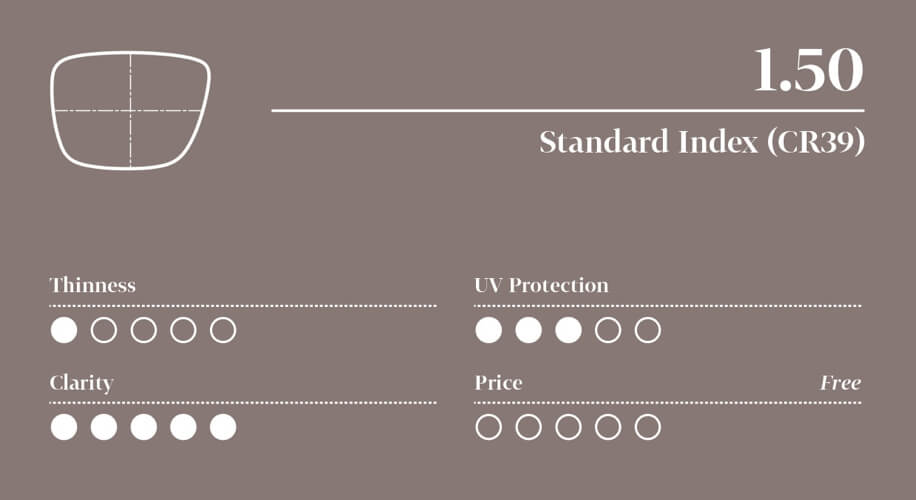
1.50 Standard index lenses
The standard index lenses, with a refractive index of 1.50, are ideal for individuals with low to moderate prescriptions. These lenses offer good optical performance and are relatively thicker than higher-index alternatives. They are a cost-effective choice for those looking for a budget-friendly option or requiring only minor vision correction. The lenses are also available as 1.50 Blokz Basic Index if you want blue light filtering lenses.
Benefits of 1.50 Mid index lenses:
- Affordability: Standard index lenses are generally the most economical option.
- Low to moderate prescriptions (range +1.00 to -2.75): They work well for individuals with mild myopia (nearsightedness) or hyperopia (farsightedness).
- Suitable for full-rim frames.
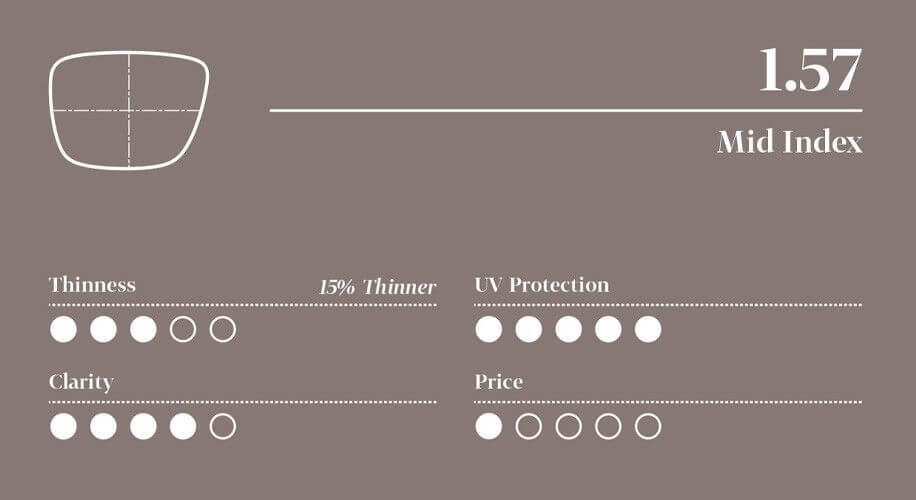
1.57 Mid index lenses
Mid-index lenses strike a balance between thickness and affordability, making them suitable for a wider range of prescriptions. With a refractive index of 1.57, these lenses are up to 15% thinner than 1.50 standard index lenses, providing improved aesthetics and comfort.
Benefits of 1.57 Mid index lenses:
- Thinner and lighter: Mid-index lenses reduce lens thickness, enhancing comfort and reducing the overall weight of your glasses.
- Moderate prescriptions (range +2.00 to -3.75): They are well-suited for individuals with moderate myopia or hyperopia, delivering better visual performance without compromising on style.
- Suitable for full-rim frames.
1.61 vs 1.67 High Index Lenses
The 1.61 and 1.67 high-index lenses are designed for individuals with higher prescriptions, addressing the concerns of thickness and weight associated with stronger corrective powers.
Benefits of 1.61 and 1.67 High Index Lenses:
- Thinner and lighter: High-index lenses significantly reduce lens thickness and weight, resulting in a more aesthetically pleasing and comfortable wearing experience.
- 1.61 High index lenses are up to 20% thinner than 1.50 Standard index lenses.
- 1.67 High index lenses are up to 30% thinner than 1.50 Standard index lenses.
- Stronger prescriptions: They are recommended for individuals with high myopia or hyperopia, providing optimal vision correction while minimizing lens bulkiness.
- 1.61 High index lenses are best for the range +3.00 to -5.75.
- 1.67 High index lenses are best for the range +4.75 to -6.75.
- Suitable for full-rim, half-rim or rimless frames.
1.74 High index lenses
The 1.74 High-index lenses are the thinnest and lightest option available at Zenni. The lenses are specifically designed for individuals with very high prescriptions, aiming to deliver excellent visual clarity without compromising on style or comfort.
Benefits of 1.74 High index lenses:
- Thinnest and lightest: Super high-index lenses offer the utmost reduction in lens thickness and weight, resulting in sleek and lightweight glasses.
- Strong prescriptions (range +5.00 to -7.00): They are suitable for individuals with severe myopia or hyperopia, allowing for the highest level of vision correction while minimizing lens thickness.
- Suitable for full-rim frames.
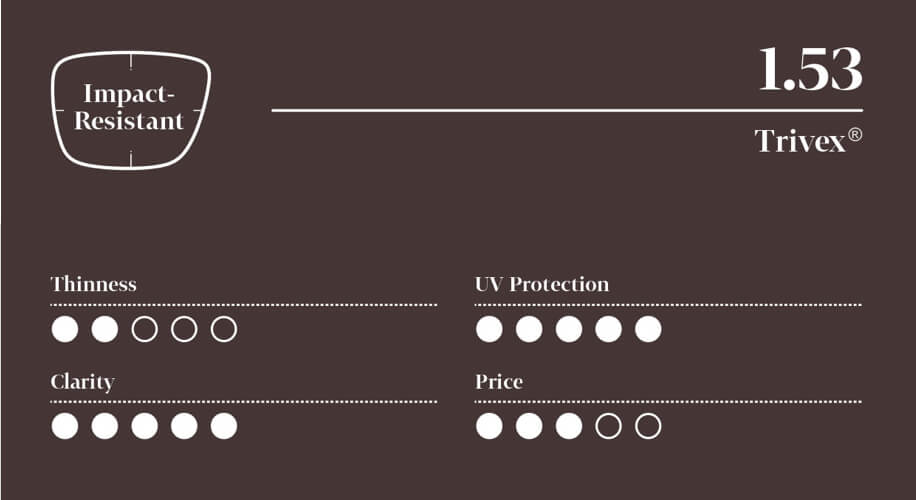
1.53 Trivex® impact resistant lenses
1.53 Trivex® impact-resistant lenses offer superior clarity, durability, and comfort, making them suitable for various prescriptions. The lenses are also available as 1.53 Blokz Trivex® impact resistant if you want blue light filtering lenses.
Benefits of 1.53 Trivex® impact resistant lenses:
- Impact-resistant: Trivex lenses are highly durable and resistant to impact, offering added protection for your eyes and increased longevity for your glasses. They are perfect for children and sports glasses.
- Ultra-lightweight: These lenses are lightweight, making them comfortable to wear for extended periods without feeling heavy on your face.
- Mild to moderate prescription (+2.00 to -3.00): Trivex lenses can effectively correct a wide range of prescriptions, from mild to moderate, providing optimal vision correction for many individuals.
- Suitable for all frames.
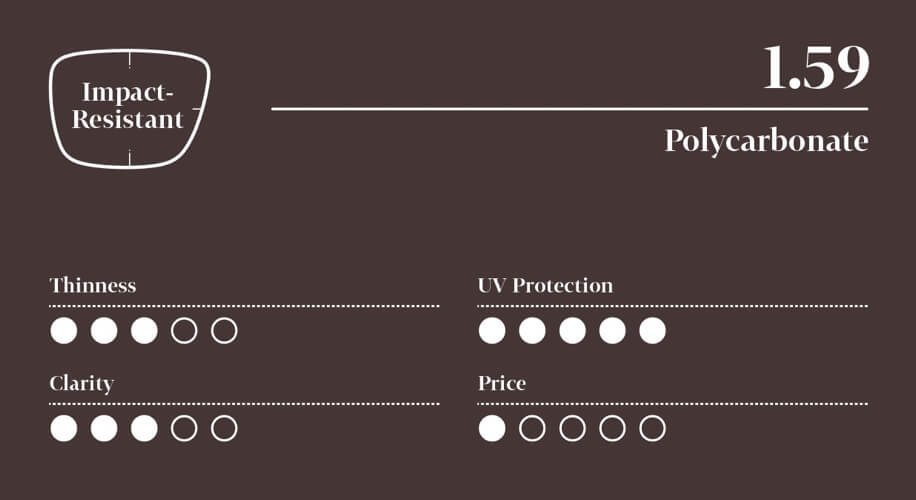
1.59 Polycarbonate lenses
Polycarbonate lenses, with a refractive index of 1.59, are known for their durability, thinness, and safety features. They are a popular choice for those seeking lightweight and protective eyewear.
Benefits 1.59 Polycarbonate Lenses:
- Impact-resistance: Polycarbonate lenses are highly resistant to impact, making them ideal for individuals involved in sports or activities where eye protection is crucial.
- Thin and Lightweight: These lenses are thinner and lighter than regular plastic lenses, offering enhanced comfort and reducing the strain on your nose and ears.
- Versatile prescription range (+3.00 to -4.75): These lenses are suitable for a wide range of prescriptions, and can be used for even higher prescriptions for ages 18 or under.
- Great for kids: Polycarbonate lenses are commonly recommended for children’s eyewear due to their impact resistance and durability, ensuring both safety and comfort.
- Suitable for all frames.
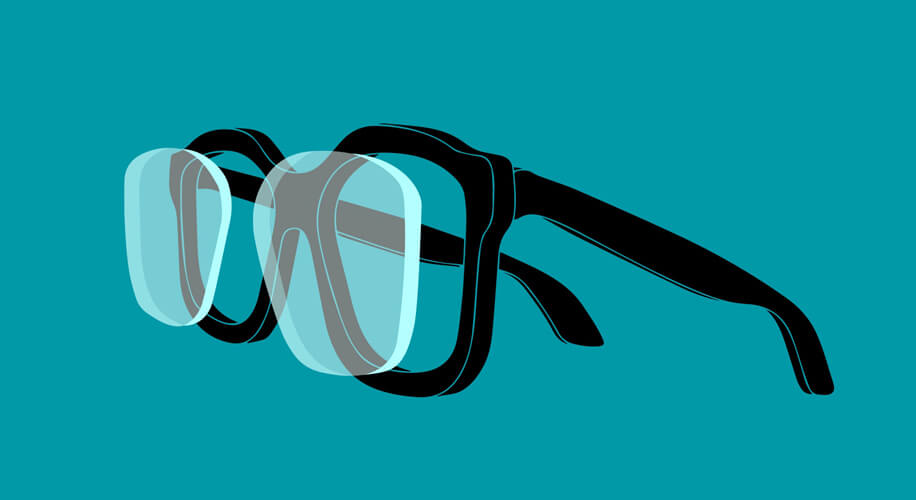
What affects lens thickness?
When buying glasses, there are three primary factors that affect your overall lens thickness:
- Prescription: Your prescription is what will ultimately determine how thick your lenses will be. Simply put, the higher the prescription, the thicker the lens. In addition, prescriptions with moderate to high astigmatism correction often result in thicker lenses.
Related Content: How to Read Your Prescription - Lens Material or Lens Index: The lens index refers to the “index of refraction,” or how much the lens bends the light that enters it. This ensures that the light is focused properly onto the retina, helping you to see clearly when wearing your glasses. In general, the higher the index, the thinner the lens. (For example, a 1.61 lens is thinner than a 1.50 lens.) During the checkout process at Zenni, choosing a higher lens index will be the most direct way to ensure you have the thinnest lenses possible.
- Lens Size: The overall width and height of your lenses can have a considerable impact on the thickness of the lenses themselves. The bigger the lens, the thicker it tends to be. When buying frames at Zenni, the lens width and height are predetermined based on your chosen frame. Aside from choosing frames based on factors like style and face shape, you should also shop based on size.
About the Author: Dr. Mori Ahi, O.D.
Dr. Mori has over 10 years of experience in eye care. She earned her undergraduate degree from UCLA and her optometry degree from the New England College of Optometry. She has worked in a variety of eye care settings and is passionate about helping her patients find a great pair of affordable glasses



 Canada
Canada